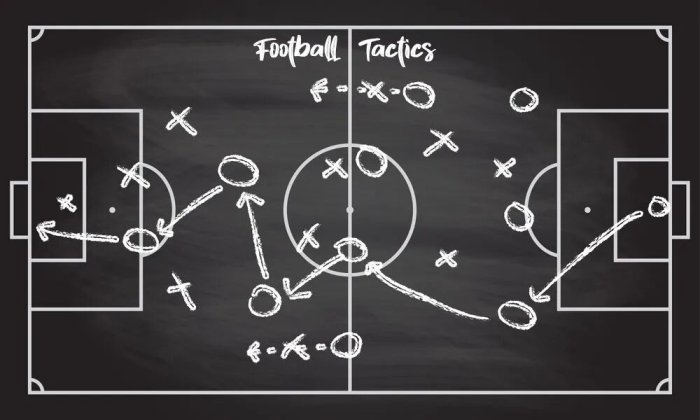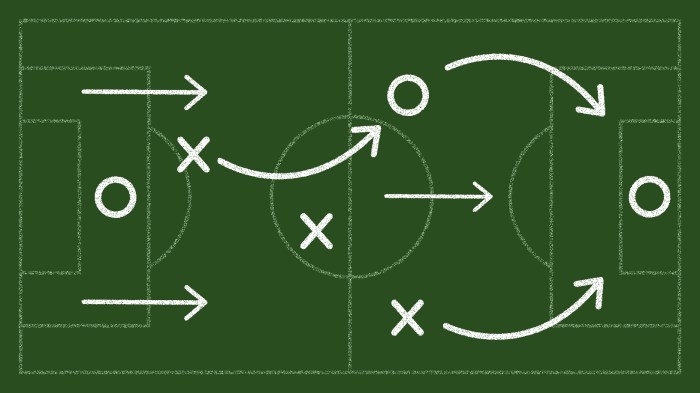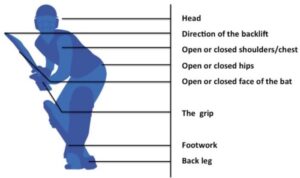Football tactics are the key to unlocking victory on the field, where strategic maneuvers and clever plays can make or break a team’s success. Get ready to dive into the world of football tactics and uncover the secrets behind the game-changing strategies that shape every match.
From offensive powerhouses to defensive stalwarts, every aspect of the game is influenced by the tactical decisions made by coaches and players. Let’s explore the intricate dance between tactics and triumph in the world of football.
Introduction to Football Tactics
Football tactics refer to the strategic plans and decisions made by a team to achieve their goals on the field. These tactics involve formations, player positioning, and style of play that aim to outsmart and outmaneuver the opponent.
Importance of Tactics in a Football Match
- Tactics determine how a team plays both defensively and offensively, affecting their chances of scoring goals and preventing the opponent from doing so.
- Effective tactics can exploit the weaknesses of the opposing team while minimizing the impact of their strengths.
- Adapting tactics during a match can turn the tide in favor of a team, especially when facing unexpected challenges or changes in the game.
How Tactics Influence the Outcome of a Game
- Well-executed tactics can lead to better ball possession, more scoring opportunities, and greater control over the game.
- Defensive tactics can help a team withstand pressure from the opponent and minimize the chances of conceding goals.
- Tactical decisions such as substitutions or formation changes can directly impact the flow and momentum of a match, ultimately determining the final result.
Types of Football Tactics

Football tactics are crucial in determining the style of play a team adopts on the field. There are various types of tactics used by teams to gain an advantage over their opponents.
Tiki-Taka
Tiki-taka is a possession-based style of play that focuses on short passing and movement, aiming to retain possession and create scoring opportunities through quick combinations. Teams known for employing tiki-taka include Barcelona and Spain’s national team.
Counter-Attacking
Counter-attacking tactics involve quickly transitioning from defense to attack to exploit spaces left by the opponent. Teams like Atletico Madrid and Leicester City are known for their effective use of counter-attacking strategies.
High Press
High press tactics involve putting pressure on the opponent high up the pitch to force turnovers and create scoring chances. Teams such as Liverpool under Jurgen Klopp and Manchester City have been successful with their high pressing style.
Offensive Tactics
In football, offensive tactics play a crucial role in creating goal-scoring opportunities and dominating the game. Teams employ various strategies to break down the opponent’s defense and create chances to score.
Possession-based Play
Possession-based play focuses on controlling the ball and maintaining a high percentage of possession. Teams use short, quick passes to move the ball around, forcing the opposition to chase and tire out. By dominating possession, teams can dictate the pace of the game and create openings in the opponent’s defense.
Direct Attacking
Direct attacking involves quickly transitioning from defense to offense, bypassing the midfield with long passes or through balls. This tactic aims to catch the opposition off guard and exploit spaces behind their defensive line. Teams that use direct attacking rely on speedy forwards and accurate long passes to create goal-scoring opportunities.
Wing Play
Wing play focuses on utilizing the width of the field to stretch the opponent’s defense and create space in the middle. Teams with strong wingers use overlapping runs, crosses, and one-on-one dribbling skills to deliver dangerous balls into the box. Wing play can be an effective tactic to penetrate the opponent’s defense and create scoring chances from crosses or cut-backs.
Formations play a vital role in offensive strategies, as they determine the positioning of players on the field and how they interact with each other. For example, a 4-3-3 formation might prioritize wing play with wingers providing width and full-backs overlapping, while a 4-4-2 formation might focus on direct attacking with two strikers up top. Coaches choose formations based on their team’s strengths, the opponent’s weaknesses, and the style of play they want to implement.
Defensive Tactics
In football, defensive tactics are crucial for teams looking to prevent the opposing team from scoring. Teams employ various defensive strategies such as zonal marking, man-to-man marking, and parking the bus to protect their goal and secure a victory.
Zonal Marking
Zonal marking is a defensive tactic where players are assigned specific zones on the field to cover rather than marking individual opponents. This ensures that all areas of the field are protected, making it difficult for the opposing team to find space to attack.
Man-to-Man Marking
Man-to-man marking involves assigning a player to mark a specific opponent throughout the game. This strategy is effective in nullifying the threat posed by key players on the opposing team, as the assigned player is responsible for tracking their movements and limiting their impact on the game.
Parking the Bus, Football tactics
Parking the bus is a defensive strategy where a team prioritizes defense by packing the area around their goal with players. This tactic aims to frustrate the opposing team by making it difficult for them to break through the defensive line and score.
Teamwork and communication are essential in defensive strategies, as players need to work together cohesively to anticipate the movements of the opposing team and react accordingly. Effective communication ensures that players are organized and able to quickly adjust their positions to counter the attacking threats posed by the opposition.
Set-Piece Tactics: Football Tactics
Set-piece tactics play a crucial role in football as they provide teams with strategic opportunities to score goals or prevent the opponent from scoring. Whether it’s a corner kick, free-kick, or throw-in, these set-piece situations require careful planning and execution to maximize their effectiveness on the field.
Attacking Set-Piece Tactics
- Corner Kicks: Teams often use various set-piece routines to create scoring opportunities from corner kicks. This can involve players making specific runs, using decoy movements, or employing different types of deliveries to surprise the opposition.
- Free-Kicks: Free-kicks near the opponent’s goal can be a prime scoring chance if executed correctly. Teams may opt for direct shots on goal, intricate passing plays, or even set up a well-rehearsed set-piece routine to catch the defense off guard.
- Throw-Ins: While not as common as corner kicks or free-kicks, throw-ins can also be utilized as set-piece tactics. Teams may have special plays designed to capitalize on throw-in situations near the opponent’s penalty area.
Defensive Set-Piece Tactics
- Corner Kicks: Defending teams must organize themselves effectively to prevent the opposition from scoring from corner kicks. This can include assigning specific marking responsibilities, setting up zonal defenses, or employing man-marking tactics to clear the ball away from danger.
- Free-Kicks: Defending against free-kicks requires a solid defensive wall, proper positioning of players, and quick reactions to block shots or intercept passes. Teams may also employ offside traps or other tactics to disrupt the opponent’s set-piece routines.
- Throw-Ins: Similar to corner kicks, defending throw-ins near one’s own goal demands focus, communication, and coordination among defenders to eliminate any potential threats and regain possession of the ball.
Teams Known for Set-Piece Excellence
- Liverpool FC: Liverpool has been known for their deadly set-piece routines, with players like Trent Alexander-Arnold delivering pinpoint crosses and Virgil van Dijk dominating aerial duels in both attacking and defending situations.
- Tottenham Hotspur: Tottenham’s set-piece tactics, under the guidance of coach Jose Mourinho, have been effective in creating scoring chances and securing goals from corner kicks and free-kicks.
- Atletico Madrid: Known for their defensive solidity, Atletico Madrid excels in defending set-pieces with organized zonal marking and disciplined positioning to thwart opponents’ attacking threats.
Tactical Adjustments

When it comes to the game of football, tactical adjustments play a crucial role in determining the outcome of a match. Coaches must be able to analyze the flow of the game, assess the strengths and weaknesses of both their own team and the opponent, and make strategic changes on the fly to gain an advantage.
Making tactical adjustments during a game is important as it allows teams to adapt to the ever-changing circumstances on the field. Whether it’s switching formations, altering player positions, or changing the style of play, these adjustments can turn the tide of a match in favor of the team making them.
In-game Tactical Changes
- Substituting an attacking player for a more defensive-minded one to protect a lead.
- Switching to a high-pressing strategy to regain possession in the opponent’s half.
- Shifting to a counter-attacking approach to exploit the opponent’s defensive vulnerabilities.
Analyzing Opponents for Adjustments
Coaches analyze opponents by studying their recent matches, identifying key players, and understanding their tactical tendencies. By recognizing patterns in the opponent’s play, coaches can devise effective strategies to counter their strengths and capitalize on their weaknesses.
In conclusion, tactical adjustments in football are essential for teams to stay competitive and maximize their chances of success on the field. Coaches who can make quick and effective changes during a game are often the ones who come out on top in the end.
Historical Evolution of Football Tactics
Football tactics have come a long way from the traditional formations of the past to the modern-day strategies seen on the pitch. The evolution of tactics in football has been a fascinating journey, shaped by innovation, strategic thinking, and the quest for success.
Traditional Formations
In the early days of football, players were typically organized in simple formations like the 2-3-5 or the WM formation. These formations focused on attacking play and physicality, with little emphasis on defensive structure.
Development of Tactical Approaches
Over time, coaches and teams began to experiment with different tactics to gain a competitive edge. The introduction of the offside rule in 1863 led to the rise of more structured defensive strategies, while the introduction of zonal marking in the 1960s revolutionized the way teams defended against opponents.
Key Milestones in Tactical Evolution
One key milestone in the development of football tactics was the introduction of Total Football by Dutch coach Rinus Michels in the 1970s. This revolutionary playing style emphasized fluid movement, positional interchange, and pressing, influencing the tactics of many teams around the world.
Modern-Day Strategies
Today, football tactics have become more sophisticated and specialized, with teams employing intricate formations, pressing schemes, and set-piece routines to gain an advantage on the field. Innovations in tactics continue to shape the way the game is played, challenging coaches and players to adapt and evolve in response to new trends and strategies.
Role of Technology in Analyzing Tactics
Technology plays a crucial role in modern football by providing valuable insights into analyzing and improving tactics used by teams. Utilizing various tools and software, coaches and analysts can enhance their understanding of the game, leading to more effective strategies on the field.
Tools and Software for Tactical Analysis
- Video Analysis Software: Programs like Hudl and Nacsport allow teams to break down game footage, analyze player movements, and identify patterns in gameplay.
- GPS Tracking Devices: Wearable technology provides data on player performance metrics such as distance covered, speed, and acceleration, helping coaches optimize training sessions and game strategies.
- Data Analytics Platforms: Advanced statistical tools like Opta and StatsBomb offer in-depth insights into player and team performance, enabling teams to make data-driven decisions in tactics and player selection.
Impact of Data Analysis on Decision-making
-
Data-driven Decisions:
Coaches can use data analytics to identify strengths and weaknesses in their team’s tactics, leading to more informed decisions on strategy adjustments and player positioning.
-
Improved Performance:
By analyzing data on player fitness and match statistics, teams can optimize training regimes and game plans, ultimately enhancing overall performance on the field.
-
Scouting and Recruitment:
Data analysis allows teams to scout potential players based on specific performance metrics, helping in recruitment decisions that align with the team’s tactical requirements.




